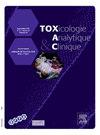Fatal intoxication of 1-Thiophen-2-yl-2-MethylAminoPropane(-2-MPA): Forensic case report
IF 1.8
Q4 TOXICOLOGY
引用次数: 0
Abstract
Aim
To identify whether 2-MPA was the cause of the death or not.
Case
A 27-year-old man who had drunk several large pints and had used some novel psychoactive substances (NPS) was found unconsciousness early in the morning in his room with some plastic packets, where two of them were opened and one sealed contained white tablets (jumping beans). The tablets were found adjacent to the dead body. He was brought to a Kaciyru hospital (Kigali, Rwanda); at the hospital, he was found to be unresponsive with no mental state and a lack of coordination. The autopsy was conducted as per the request from the Rwanda Investigation Bureau (RIB) and the findings revealed that there were no marks; the body did not show any decomposition and both the internal and external examinations showed no evidence of injury. The brain appeared congested and edematous; kidneys, lungs, and liver appeared congested, and the heart appeared normal. 10 mL of blood sample was collected directly from the heart. The postmortem report indicated sudden cardiac death through cardiac dysrhythmia, but there was no medical history of previous heart disease.
Method
The cardiac blood sample and the packets of jumping beans were collected and analysis was carried out for drug intoxication. Physical examination of the drug was performed using the microscopic technique; The Fourier Transform Infrared (FTIR) spectrometer was used as confirmatory analysis. The proton nuclear magnetic resonance 1H-NMR was used to record the proton NMR of the target compound. NPS from post-mortem cardiac blood samples was analyzed by SPE-GC-MS after appropriate sample pretreatment procedures.
Results
The finding suggested the presence of methiopropamine (2-MPA) in the suspected seized drug. Moreover, the structural isomer of 2-MPA was detected and the concentration of 2-MPA in the decedent's blood was 752 ± 26 ng/mL.
Conclusion
The preliminary presumptive blood test revealed that the suspected drug gave a positive result with GC-MS analysis. Besides, the FTIR and NMR confirmed that the suspected drug was 2-MPA. The quantitative determination of MPA was also performed using GC-MS and the result showed that a high concentration of MPA was reported as acute toxicity was obtained in the cardiac blood. Thus, the cause of death was certified as acute 2-MPA intoxication.
1-噻吩-2-酰基-2-甲基氨基丙烷(-2-MPA)致死性中毒:法医病例报告
目的探讨2-MPA是否为死亡原因。一名27岁的男子喝了几大品脱酒,并使用了一些新型精神活性物质(NPS),凌晨在他的房间里被发现昏迷,里面有一些塑料包装,其中两个被打开,一个被密封,里面装有白色药片(跳豆)。这些药片是在尸体旁边发现的。他被送往Kaciyru医院(卢旺达基加利);在医院,他被发现没有反应,没有精神状态,缺乏协调。尸体解剖是按照卢旺达调查局的要求进行的,结果显示没有任何痕迹;尸体没有任何腐烂的迹象,内部和外部检查都没有发现受伤的迹象。脑充血水肿;肾、肺、肝充血,心脏正常。直接从心脏采血10ml。验尸报告显示心脏性猝死是由心律失常引起的,但没有既往心脏病病史。方法采集心脏血样和跳豆包,进行药物中毒分析。采用显微技术对药物进行体格检查;采用傅里叶变换红外光谱仪(FTIR)进行验证分析。利用质子核磁共振1H-NMR记录目标化合物的质子核磁共振。在适当的样品预处理程序后,采用SPE-GC-MS分析死后心脏血液样品中的NPS。结果检出的疑似药物中含有甲氧丙胺(2 mpa)。检测2-MPA结构异构体,死者血液中2-MPA浓度为752±26 ng/mL。结论初步推定血液检查显示该可疑药物经气相色谱-质谱分析呈阳性。FTIR和NMR证实疑似药物为2-MPA。同时采用气相色谱-质谱法对MPA进行了定量测定,结果表明,心脏血液中有高浓度的MPA,具有急性毒性。因此,死亡原因被证实为急性2-MPA中毒。
本文章由计算机程序翻译,如有差异,请以英文原文为准。
求助全文
约1分钟内获得全文
求助全文

 求助内容:
求助内容: 应助结果提醒方式:
应助结果提醒方式:


